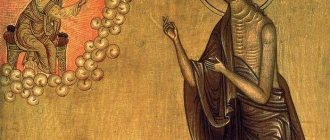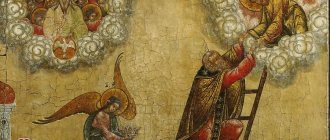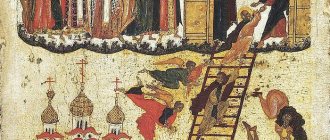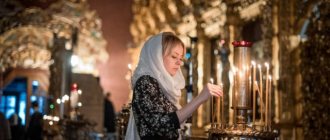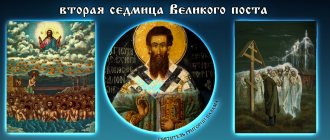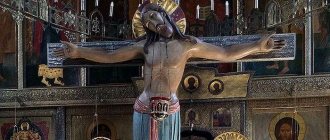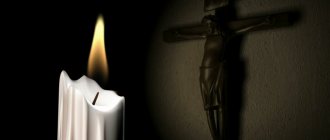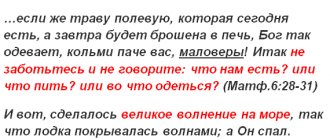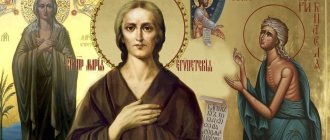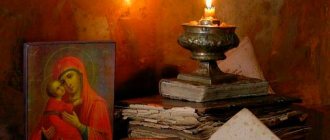On the fifth Sunday of Great Lent, the memory of the Venerable Mary of Egypt - one of the greatest saints in the entire history of Christianity. Her fate is an example of deep repentance and at the same time a reminder of God’s love for mankind. The Venerable Mary of Egypt is also commemorated on April 14 (April 1, Art.), the day of her repose. Through the prayers of the Venerable Mary, believers can receive deliverance from fornication.
Venerable Mary of Egypt. Biography
The Venerable Mary was born in Egypt in the middle of the 5th century.
“It is good to keep the secret of the king, but it is glorious to preach the works of God” [], - this is how St. begins his story. Patriarch of Jerusalem Sophronius the Wise (11/III, 638-644), telling about the life and exploits of the Venerable Mary of Egypt - one of the most famous Christian desert dwellers.
“None of you disbelieves me, having heard these scriptures, and do not think that you are proud of me, marveling at this great miracle. Do not let us lie to the saints; If they are the people who read these books, and marvel at the height of the words, and do not want to believe, may the mercy of the Lord be upon them. This is because the human weakness that we speak about people creates is thoughtlessly unpleasant” [].
In the narration of the life of St. Mary encounters many things that far exceed human nature, but, as is known from the Gospel, for the holy wonderworkers, with the help of God, nothing is impossible: thus, having overcome their old man, they lived like disembodied angels already here on earth. St. Sophrony mentions a whole monastery of such ascetics, among whom was St. Elder Zosima (460-560), who accidentally discovered an Egyptian hermit while practicing intense prayer feats during Lent.
Zosima himself lived in a monastic monastery from his childhood and never became involved in worldly pursuits. Having reached a certain degree of spiritual perfection, he began to think to himself whether there were other workers who would be higher than him in virtues. Then the Angel of the Lord opened to him in the Jordanian desert one such monastery, the inhabitants of which were distinguished by a particularly strict life in spiritual exploits. Here, according to custom, at the beginning of Great Lent, all the monks went into solitude and remained so until Flower Sunday, when they returned back to arrive in time for the festive church service.
In the Jordanian desert, where the venerable hermits lived, it was impossible to meet not only humans, but even wild animals or birds. Therefore, noticing the figure of the hermit from afar, Elder Zosima was both happy and frightened, embarrassed by the thought that the vision was imaginary. She was “naked in body, and black in vision, from the burning of the sun. The hair on the head is white, like a wave, and short, as if reaching up to your neck.” But the saint, taking half of the old robe from the elder to cover his bodily nakedness, hastened to calm him down and made the sign of the cross. Zosima marveled more and more and thanked God for this wonderful acquaintance. Thus, Mary showed herself to be a seer, for she easily called an old man unknown to her both by name and rank (St. Zosimas was a priest), and when she began to pray, then, as if disembodied, she ascended a full cubit from the ground and quoted miraculously recognized her texts of Scripture. But to all questions about her life, the hermit answered that she was a great sinner, filled with all kinds of lawlessness, which would be terrible to both tell and listen to.
Entreated by the elder, Maria began to tell that, being only twelve years old, she secretly left her parental home and settled in Alexandria. Here, still very young and inexperienced, she completely abandoned herself to a vicious life and carnal pleasures. Maria spent about seventeen years in this way, although she then lived very poorly and earned money from needlework:
“I have been for seven and ten years and more, giving my body to everyone without restraint, and accepting bribes from no one: this is the truth, and it is forbidden to give to those who want to give to me. Behold, I have many intentions, so that I may acquire many, come to me once, and put an end to my desire. Don’t think of me as if I were rich and don’t take it: I’m living in poverty, even though I’ve been raked many times, but my desire is not satisfied and my zeal cannot be restrained, I’m always wallowing in time. The same is true for life, which always creates bodily desires” [].
Once during the harvest, Mary saw how many people from Egypt and Libya flocked to the sea pier to a ship sailing to Jerusalem for the Feast of the Exaltation of the Honorable Cross of the Lord. Here she decided to go along with everyone, but very frivolously: for the sake of fun and new meetings. So, both on the ship and in Jerusalem itself, Mary did not lag behind her custom, but remained in her former carelessness and sinful pleasures. In deep humility, she now confessed this to the reverend elder, not hiding anything from her experience:
“What else will we confess, Father; or what tongue will utter; or who hears, my former evil deeds, on the way and in the ships, as those who do not want to, but I am accursed in need, a shameless form of committing fornication, spoken and indescribable, he would be a teacher of the accursed deed. Through them I believe, Father, I marvel at how the sea has endured my fornication. No matter how the earth opens its lips, and does not lead me to hell alive, I have deceived so many souls. But I remember that God sought my repentance, for He does not want death as a sinner, but waits patiently for my repentance” [].
When the time for the great celebration arrived, Mary, along with many people, hurried to the church to venerate the Cross. And then, for the first time in all the past years, she suddenly saw and understood how sinful and destructive her current state was: the invisible power of God did not allow her to go inside and stand in the holy place. All the people walked and moved forward, but Maria remained in the vestibule and tried to squeeze through with them, but as soon as her foot touched the church threshold, she again found herself behind, embarrassed and confused. This went on three or four times. Then Mary, realizing that it was the Hand from Above who was punishing her for her sins, turned to the icon of the Most Pure Theotokos with words of the most sincere repentance and contrition of heart:
“I retreated to the corner of the church porch, and barely came to the feeling that it was for my sake that the Life-Giving Cross was forbidden. The Son touches the Word before the eyes of my heart, and with demonstrations, as though he were imprisoned for the sake of my deeds, he forbids my entry. And then he began to cry and sob, and beat his heart, exhausting sighs from the depths of his heart. Weeping in the place where we stood, and looking up in front of her, and seeing the icon of the Most Holy Theotokos standing, and reaching out to Her, not shyly looking: “O Virgin Lady, Who gave birth to the flesh of God the Word. I know that it is neither godly nor pleasing for me to behold the filthy harlot on your venerable icon of the ever-Virgin Mary. It is righteous for me to be a harlot, who hates to be Your purity, and abhors You. But I heard that for this reason God was a man, and you gave birth to Him, so that sinners may call to repentance, help me alone, who does not have any help; commanded that my entry into the Church should not be weak... You and the Handmaid be pleased with me, to the One who was born of You, as I am no longer able to defile this flesh with any defilement of the flesh. But when I see the Tree of Christ Your Son, I will renounce this world and then I will go forth, perhaps You, the Surety, will guide me” [].
Thus, humbly reproaching herself, Mary was finally vouchsafed to venerate the Life-Giving Cross of the Lord without restraint. Returning back to the porch to the icon of the Mother of God, she fell before Her with joy and fear, praying to the Most Holy Virgin to be her Teacher for salvation from now on. And the Most Pure Mother of God did not despise her heartfelt petition, but there was a response voice from the icon: “If you cross the Jordan, you will find good peace” []. Having once again thanked the All-Merciful Mother of God with tears and received Holy Communion, Mary went to the Jordan. There she found a small boat for herself and, having moved to the opposite shore, she remained in the depths of the desert, never having seen, until now, a human face. The only person who saw Mary after she left for the desert was the monk Zosima.
Next, Mary told the elder what she had experienced, having labored for forty-seven years in such a harsh area, where there was neither water nor any other food except rare desert herbs. Unable to renew her clothes, which had decayed over time, she suffered a lot from the heat of the midday and the cold at night, and many times, exhausted, she lay, as if already lifeless, on the bare ground. It was especially hard for her in the early years, when she was still tempted by worldly memories:
“I believe in them, Abvo Zosimo, who spent sixteen years in this desert, as if fighting with fierce beasts, struggling with their own thoughts. Whenever we first ate food, we craved meat and fish, like they had in Egypt. Although I drink the wine of my beloved, I drank a lot of wine while I was in the world. Here, having no water to taste, they became angry and suffered less. You have also had the desire to sing fornicating songs, fiercely disturbing me, and singing songs of demons that have become a habit in the world. Abie shed tears, and beating her heart with faith, remembering the vows she made, venturing into this desert. My thoughts went to the icon of the Most Holy Theotokos, my Surety, and I cried to Toya, asking him to drive away my thoughts, my melting, damned soul. When I was content with weeping and beating diligently in my heart, then I saw the light shining everywhere on me, and there was great silence in the storm where I was” [].
Having finished her story, Mary asked the venerable elder the following year, on Holy Thursday, to approach the Jordan, preparing for her a vessel with the Holy Mysteries. At the same time, she predicted to him that this time, even if he wanted to, he would not, as usual, be able to retire to the desert for Lent.
Returning to his monastery, Zosima did not announce his ex to anyone, but looked forward to the next year to see the saint again. Physical illness really did not allow him to go out into solitude with everyone else, but on Holy Thursday he hurried to the appointed place, having prepared the Holy Mysteries and some hermit food. Since Mary did not appear for a long time, the elder, standing on the shore, began to think with anxiety whether something had happened that would serve as an obstacle to such a desired meeting. He was also overcome by other doubts: how could she get across the river, having neither a boat nor a bridge to cross here. While he was still thinking this way, the venerable one, finally showing herself and making the sign of the cross, quickly walked towards him over the water as if she were walking on a solid road.
Having communed with reverence of the Most Pure Body and Blood of Christ, Mary read the prayer of St. righteous Simeon the God-Receiver: “Now you release your servant, Master...” and asked Zosima the next year to come to her again at the place of their first meeting, predicting to him that then he would be able to see her again, but in the way the Lord willed. The elder, returning back, marveled at himself that he did not remember in time to ask the very name of the saint. At the request of Mary, Zosima returned exactly a year later to the place of their first meeting and saw the body of the saint lying on the sand, and next to it was the inscription:
“Bury Abvo Zosimo in this place the body of the wretched Marya, give dust to dust. For the Lord’s sake, pray for me, who died, on the month of Pharmutia in Egyptian, and in Roman Aprilia, on the first day, on the very night of the saved Last Supper.”
Zosima realized that after he gave Mary communion a year ago, she was miraculously transported to this place, where he walked for 20 days, and reposed in the Lord. But here, too, the Lord showed him another miraculous sign: a huge lion, unknown how it ended up in this uninhabited place, began, at the command of the monk, to dig a grave pit with its claws for burial. Thus rested the long-suffering body of this great ascetic, who had nothing with her except that wretched, torn robe that she received from the holy elder.
This time Zosima already told everything that had happened to the abbot and the brethren, not hiding anything from them, but blessing God for His glorious miracles. As Patriarch Sophrony writes, the monks initially conveyed this story to each other orally, but when he found out, he decided to commit what he heard to scripture in order to preserve it for edification for future generations.
“May God give reward to those who honor this, and to those who listen, and to the one who commanded this story to be written” [].
History of Saint Mary
Mary was born in Egypt in the fifth century AD. She stayed in her parents' house until she was twelve years old, after which she left for Alexandria, which at that time was a developed cultural and economic center. Where there is prosperity and luxury, there is almost always lust and other sins.
Therefore, Mary succumbed to licentiousness and began to indulge in bodily pleasures. For many years she allowed herself any passions and fornicated a lot. For her, it was bodily pleasure that was the main meaning and the highest bliss.
As the lives testify, Mary, for about 17 years, continually and daily indulged her own passions, in particular, she indulged in fornication. She did not collect money, she simply enjoyed bodily pleasures.
Upon reaching the age of 29, Mary went by ship to the Feast of the Exaltation of the Holy Cross, which was celebrated in Jerusalem. It was this event that became fundamental in the biography of this saint, and it was thanks to this that the woman was able to accept the true faith. At the same time, she initially went to the holiday in order to fornicate there, but she saw people going to the temple.
Venerable Mary of Egypt. Divine service
On the evening of Wednesday of the fifth week of Lent, the service “ Standing of Mary ” is performed with the reading of the Great Canon of St. Andrew of Crete. On each verse, the worshipers make three prostrations - throwings, there are 798 of them in total. And together with the prostrations at Vespers, Vespers and the Hours, the result is about a thousand prostrations. On this day, the penitential Canon of Andrei of Crete is read in full.
Library of the Russian Faith Great Canon of St. Andrey Kritsky →
Read online
So that those praying can rest a little, according to the Church Charter, during the service the life of the great ascetic St. Mary, included in the Lenten Triodion, is read. On the following Sunday, the Church honors the memory of the Venerable Mary of Egypt. The canon of the saint was written by Simeon Metaphrastus.
Library of the Russian Faith Canon of St. Mary of Egypt →
Read online
Troparion, tone 8.
About you, Mother Mary, the speed of salvation is known. Having accepted the cross, you followed Christ. Those who create and teach, even if they despise the flesh, will pass away, but be diligent about souls, things that are more immortal. In the same way, your holy spirit rejoices with the angels.
Kontakion, tone 4.
Having fled the darkness of sin, and having illuminated your heart with the light of repentance, you came to Christ. This most immaculate and holy Mother, brought a merciful intercessor. From this you will find remission through sin, and with the angels you will rejoice forever.
Library of the Russian Faith Life of the Venerable Mary of Egypt. Great Menaion of Cheti →
Read online in original
Prayer
O great saint of Christ, Venerable Mother Mary! Hear the unworthy prayer of us sinners ( names
).
Deliver us, reverend mother, from the passions that war on our souls, from all sorrow and adversity, from sudden death and from all evil.
At the hour of separation of soul and body, cast away, holy saint, every evil thought and crafty demons, for may our souls be received in peace into a place of light by Christ, the Lord our God, for from Him is the cleansing of sins, and He is the salvation of our souls, to Him due all glory, honor and worship to the Father and the Holy Spirit forever and ever. Amen.
Video of Mary of Egypt praying:
Venerable Mary of Egypt. Icons
According to tradition, the Venerable Mary of Egypt is depicted in icons naked or semi-naked, wrapped in part of the himation given to her by Zosima. The venerable may be depicted with her arms crossed on her chest, with a gesture of speaking, or with two open palms. On the icon depicting the Venerable Alexy the Man of God and Mary of Egypt from the Sretensky Monastery in Moscow, we see a speaking gesture traditional for rhetoric, in which the index and middle fingers are slightly crossed, and the thumb, ring and little fingers are closed, borrowed from ancient culture. With these gestures, the saints addressed a prayer of repentance to God and to all the people who came to the temple.
Venerable Mary of Egypt and Alexy, man of God. From the Sretensky Monastery in Moscow. Moscow, museum named after. Andrey Rublev. Mid-17th century
In Russian icon painting of the mid-second half of the 17th century, patronal images of the Venerable Mary of Egypt and Alexy, the man of God, the heavenly patrons of Tsar Alexei Mikhailovich and his first wife Maria Miloslavskaya, were widespread. Miloslavskaya considered her her heavenly patroness. Often the Venerable Mary of Egypt is depicted with Saint Zosima in episodes that are described in the iconographic original as follows: “... Mary stands naked, and Zosima gives the mantle, looking back. In another place, Zosima gives the sacrament of the Holy Mysteries, they stand by the Jordan River, a low mountain above the Jordan, near their trees, befitting desert places, are depicted” (Filimonov. Iconographic original.).
Venerable Zosima and Maria. Pill icon. Rus. 16th century
Saint Alexis the Man of God and Venerable Mary of Egypt. Spring 1648 The icon was painted for the wedding of Tsar Alexei Mikhailovich with Tsarina Maria Ilyinichna
Episodes from the Life of the Venerable Mary of Egypt. Stroganov icon-painting facial original. April 1 (fragment). Rus. End of the 16th - beginning of the 17th century. (published in Moscow in 1869). In 1868 it belonged to Count Sergei Grigorievich Stroganov
An icon with the life of the Venerable Mary of Egypt from the second half - the end of the 14th century is known from the sacristy of the Hilandar monastery on Mount Athos; its entire field is occupied by sixteen stamps, which illustrate individual scenes from the life of the saint.
In Rus', hagiographic icons of Mary of Egypt became widespread in the 17th century, which is connected, as mentioned above, with the fact that the Venerable One was the patron saint of the holy queen Mary Ilyinichna of Miloslavskaya.
Icon of the Venerable Mary of Egypt with her life. 17th century
In addition to half-length and full-length images of the Venerable Mary of Egypt, the plot of the communion of Mary by the Venerable Zosima became widespread in Byzantine and Old Russian art. In Byzantine painting, a stable iconographic scheme for this plot developed. Elder Zosima and the Venerable Mary of Egypt are depicted full-length, facing each other half-turned. Saint Zosima is dressed in a monastic cassock, a mantle and a doll, usually removed from the head. In one hand he holds a cup with the Holy Gifts, in the other - a spoon, which he brings to the lips of Mary. The Venerable Mary is depicted with her head uncovered, dressed in rags. Her thin arms are folded crosswise on her chest or extended to the Holy Chalice in a prayerful gesture.
Communion of the Venerable Mary. Fresco. Church of St. Andrei on Treska in Macedonia. Serbian Orthodox Church. 1388 - 1389
Reverend Maria. Dionysius. Fresco. Ferapontovo. 1502
Venerable Mary of Egypt with her life. Nativity Cathedral at Rogozhskoye Cemetery in Moscow
In manuscript miniatures, the story of Zosima and the Venerable Mary became the subject for illustration of the Psalter. For example, in the Kyiv Psalter (1397) two events are connected: a meeting in the rocks (Zosima turns away, holding out his outer garment to Mary); Below, on the shore, Zosima gives communion to Mary.
Meeting of Saints Zosima of Palestine and Mary of Egypt. Miniature from the Kiev-Pechersk Psalter. 1397 (RNB. OLDP. F. 6. L. 175 vol.)
Communion of the Holy Gifts
Zosima, at Mary’s request, met with her a year later, bringing with him the pre-sanctified Holy Gifts and gave her communion. This is the only time that Saint Mary of Egypt tasted the Body and Blood of the Lord. The icon, the photo of which is in front of you, depicts just this moment. When they parted, she asked to come to her in the desert in five years.
Saint Zosima fulfilled her request, but when he came, he found only her lifeless body. He wanted to bury her remains, but the hard and rocky soil of the desert did not yield to his senile hands. Then the Lord showed a miracle - a lion came to the aid of the saint. The wild beast dug a grave with its paws, where the relics of the righteous woman were lowered. Another icon of Mary of Egypt (the photo was taken from her) completes the article. This is the episode of mourning and burial of the saint.
Venerable Mary of Egypt. Paintings
Such world painters as Giotto and Jose Ribera turned to scenes from the life of the Venerable Mary of Egypt.
“Elder Zosima gives a himation to Mary Magdalene.” Fresco by Giotto in the Magdalene Chapel of the lower Basilica of San Francesco in Assisi, 1320s
"Mary of Egypt". Jose Ribera. 1641
Temples in the name of St. Mary of Egypt
In Jerusalem, in the Church of the Holy Sepulcher, there is a chapel in honor of the Venerable Mary of Egypt . The chapel belongs to the Greek Orthodox Church. , the Church of the Sretensky Monastery in Moscow was consecrated and was located east of the cathedral. The wooden temple was built in 1358. Tradition connects its construction with the execution at this place, Kuchkovo Pole, of the thousand-year-old Ivan Vasilyevich Velyaminov and his accomplice, the merchant Nekomata, whom the people considered to have suffered for the truth. In 1482, a stone church was rebuilt. In 1700, part of the relics of Mary of Egypt, brought from Constantinople by Ambassador Emelyan Ukraintsev, was placed in it. In February 1707 they were moved to the monastery cathedral. The chapel of the Presentation of the Lord was built in 1706 by manufacturer A. Milyutin. In 1784, the church was renovated with funds from A. Goncharov. Since 1832, there have been no services in the church due to its dilapidation. In 1883, the outside walls were covered with iron hoops, and supports were placed inside. In 1930, the church was destroyed and a vacant lot appeared in its place. In the 1930s When dismantling the temple, it was established that it was built no later than the 16th century.
Nikolskaya Church and St. Mary of Egypt. Photo from the book “Moscow Sretensky Monastery”. Comp. Hieromonk Joseph. M., 1911
It is unknown about Old Believer churches consecrated in the name of the Venerable Mary of Egypt.
Folk traditions on the day of memory of Mary of Egypt
The Russian people associated the name of Mary of Egypt with the legendary idea of an afterlife court, in which Mary would supposedly judge all harlots. As the peasants said, Mary can “put a lost son on the first step” and, through the prayer of her parents, save her daughter from a life of fornication. The peasants spent the day of remembrance of the Venerable Mary in abstinence. In the Tambov province and some other places on this day there was a custom of eating nothing but empty cabbage soup.
This day was also popularly called Empty cabbage soup. This was due to the fact that by this time the supply of sauerkraut was running out, so the cabbage soup on the table was liquid. Instead of cabbage, housewives added sorrel or nettle to cabbage soup.
"Go beyond the Jordan..."
After realizing her own sinfulness, the woman burst into tears. Then I saw an icon of the Mother of God in front of me. Stained with vices, she prayed before the Most Pure Virgin. The harlot repented of her sins so much and promised to change so much that the Mother of God and Christ accepted her prayer.
The woman entered the church, bowed in repentance to the Cross of the Lord, near which she heard the answer to the most important question: “What next?” The voice said:
Go beyond the Jordan, there you will find blissful peace
Mary of Egypt did just that, taking communion before crossing to the other side of the Jordan.
She had no spare clothes or food supplies. 47 years in solitude. Only three loaves of bread for food. The clothes have long since worn out. The desert climate cannot be called mild: sweltering summer heat, cold winter nights. But prayer and deep repentance nourished her, kept her warm in the cold.
Soulful teaching on the Sunday of St. Mary of Egypt
Church songwriters call the Venerable Mary of Egypt “the lamp of repentance”: her example serves as an obvious indicator of how, from the very abyss of the fall, true repentance can lead to heavenly purity. Therefore, even the most lost sinners should not despair: God’s mercy is always open to us, if only we ourselves hasten to turn to it. But we should remember that the “story of the prodigal son,” according to the interpretation of the Holy Fathers, is not only the joy of the first meeting, but also the subsequent persistent, daily work to change one’s skill from sin to virtue. And the work here can be double, compared to the eldest son who has not sinned, as, say, for a farmer who neglected his field for a long time, but in the end still decided to clean it out.
Without a doubt, reading hagiographic stories always has a beneficial effect on the spiritual growth of the inner man. For even if we do not have enough faith and strength to strive like the first saints, we can at least modestly exercise ourselves in small feats, making up for our shortcomings with humility and contrition of heart, which the Lord never rejects. It should be remembered that the commandments of God are not subject to the whims of changing fashion, and the Truth from Above does not change over time. Today, such a way of life, which the Egyptian hermit so diligently repented of, is becoming almost the norm, intensively imposed on Russian girls from Western countries. It's easy to sin, but is it easy to correct yourself later? A grave sin for the soul is like a mortal disease for the body, which is overcome with much suffering and effort and which can have its consequences for the rest of your life. Therefore, given the unsightly situation of today, one should especially fervently pray to the Venerable Mary, asking for her help in temptation from fornication, as well as spiritual admonition to repentance for those who have sinned. For it is known that there is no sin that could defeat the mercy of God, except unrepentant sin.
As a reward for all her exploits and trials, God sent Mary holiness during her lifetime
17 years
Mary struggled with passions and temptations
The first 17 years were very difficult for Maria. She constantly struggled with passions and temptations. She was constantly tempted by thoughts of her past life.
When she ate, she remembered how luxurious her meals were. And when I drank water, I wanted to drink wine.
On this icon, the saint herself stands in the center, and along the perimeter, stamps depict the main stages of her life, starting with the awareness of her sin
This is exactly how Mary had to endure all the trials. But she fought until the last.
When temptation came again, she began to pray to God. And in the end, prayer won. Out of 47 years, Maria lived like this for 17 years, enduring multiple temptations and never succumbing to them. For these efforts and hardships of life, God rewarded her.
